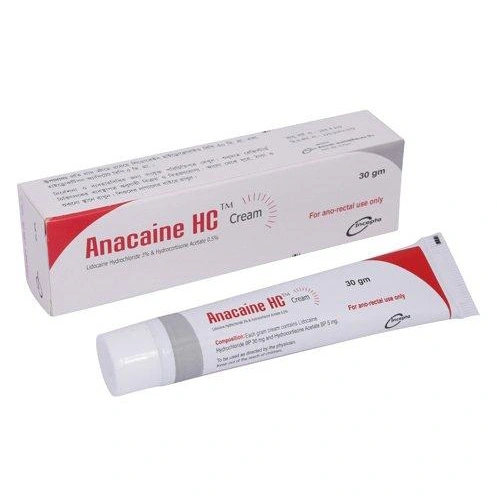Indications
Anacaine HC creamis is used for the anti-inflammatory and anesthetic relief form itching, pain, soreness and discomfort due to hemorrhoids, anal fissures, anal pruritus and similar conditions of the anal area.
* রেজিস্টার্ড চিকিৎসকের পরামর্শ মোতাবেক ঔষধ সেবন করুন
Pharmacology
Hydrocortisone is a corticosteroid used for its anti-inflammatory and immunosuppressive effects. Its anti-inflammatory action is due to the suppression of migration of polymorphonuclear leukocytes and reversal of increased capillary permeability. It may also be used as replacement therapy in adrenocortical insufficiency.
Lidocaine is an amide type local anesthesia. It stabilises the neuronal membrane and inhibits Na ion movements, which are necessary for conduction of impulses. In the heart, lidocaine reduces depolarisation of the ventricles during diastole and automaticity in the His-Purkinje system. Duration of action potential and effective refractory period are also reduced.
Lidocaine is an amide type local anesthesia. It stabilises the neuronal membrane and inhibits Na ion movements, which are necessary for conduction of impulses. In the heart, lidocaine reduces depolarisation of the ventricles during diastole and automaticity in the His-Purkinje system. Duration of action potential and effective refractory period are also reduced.
Dosage & Administration
This cream should be applied to the affected area(s) twice daily or as directed by physician. Applicator tip should be gently inserted into the anal area (areas of discomfort and anal opening). Applicator and tube should not completely insert in the anus or rectum.
Pediatric Use: Safety and efficacy in pediatric patients have not been established.
Pediatric Use: Safety and efficacy in pediatric patients have not been established.
* রেজিস্টার্ড চিকিৎসকের পরামর্শ মোতাবেক ঔষধ সেবন করুন
Interaction
This cream should be used with caution in patients receiving antiarrhythmic drugs of Class I (e.g., disopyramide, procainamide, quinidine etc), other corticosteroids/immunosuppressant drugs (e.g., cyclosporine, prednisone etc).
Contraindications
Patients with a history of hypersensitivity to any of its ingredients.
Side Effects
During or immediately following application of Anacaine Cream, there may be transient stinging or burning from open areas of skin, or transient blanching (lightening), or erythema (redness) of the skin.
Pregnancy & Lactation
Pregnancy Category C. There are no adequate and well-controlled studies in pregnant women. It is not known whether this drug is excreted in human milk.
Precautions & Warnings
If infection occurs, the drug should be discontinued. Systemic absorption may occur when extensive areas are treated and may cause suppression of hypothalamic-pituitary-adrenal (HPA) axis; avoid using for prolonged periods or with occlusive dressings. Caution should be used with impaired hepatic function and patients taking class I antiarrhythmics.
Therapeutic Class
Drugs used in Ano-rectal region
Storage Conditions
Store at controlled room temperature of 15°C to 30°C, protect from freezing. Keep out of the reach of children.

